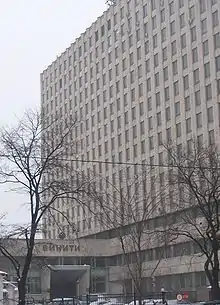VINITI
VINITI (Russian: ВИНИТИ; All-Russian Institute for Scientific and Technical Information; Russian: Всероссийский институт научной и технической информации former All-Union Institute for Scientific and Technical Information) is a subsidiary of the Russian Academy of Sciences devoted to gathering scientific and technical information from sources throughout the world and disseminating this information to Russian scientific community.[1][2]

The institute was established as the Institute for Scientific Information (Russian: Институт научной информации) in 1952. The founder of the institute was Alexander Nesmeyanov. The main office of the institute is situated in Moscow, while its publishing house is located in Lyubertsy.
The Institute publishes Referativny Zhurnal ("The Abstract Journal") and produces VINITI Database RAS.[1]
Purpose of VINITI
VINITI is the name for the Russian, and formerly Soviet, organization, All-Union Institute for Scientific and Technical Information. It was established in 1952 as a branch of the USSR Academy of Sciences. At its inception VINITI was tasked with gathering scientific and technical information from sources throughout the world, and also chartered to disseminate this information to the Soviet and socialist scientific community. By 1992 technical and scientific documents had been amassed from more than 100 countries in 60 languages, and available for dissemination. It had become the largest single source of secondary scientific and technical information in the world. 31 million citations indexed literature from 1953 to 1992. Much of the former Soviet database contained materials unique to the Eastern bloc scientific community, which was just then being made available to American, British, Western European, and Japanese scientists and researchers. [3]
In 1952 the Presidium of the USSR Academy of Sciences made a decision to set up the Scientific Information Institute in the framework of the Academy of Sciences. The main task of the Institute was to organize the informational support of basic science by centralizing the analysis, searching, and processing of information. The Government reorganized the Institute into the formerly named All-Union Institute of Scientific and Technical Information (VINITI) in 1955. VINITI began to cover not only basic science, but also applied science.
By 2002, VINITI became a team of highly skilled professionals processing more than one million scientific publications annually. It is the largest on-line data bank in Russia, which contains more than 25 million documents, The database contains the Abstract Journal which is distributed, subscribed to, and read by scientists in sixty countries, with more than 330 titles of publications, which cover all fields of basic and applied sciences. In 2002, VINITI is noted for having more than 240 databases on science and technology, economics, and medicine. In addition it has powerful retrieval systems, and a wide range of services.[4]
VINITI publications
VINITI publishes the Abstracts Journal series (Russian: Referativny Zhurnal), which has been published since 1952. The Abstracts Journal is made up of reviews and abstracts of various published materials in particular areas: books, scientific research papers, patent documents, regulatory information, technical papers, trade publications, foreign dissertations, and cartographic publications.[5]
References
- "О ВИНИТИ РАН". Official site of VINITI.
- Cherny, Arkady (2005). Всероссийский институт научной и технической информации: 50 лет служения науке (PDF). VINITI.
- "Access Innovations to distribute Russian sci-tech documents". Information Today. 9 (4). April 1992. Archived from the original on 2015-09-24. General OneFile. Web. (pay wall)
- Russian Abstract Journals in Science and Technology. Science Reference Guides. Library of Congress. December 5, 2002. Public domain content from the US Federal Government.
- "Abstracts Journal". VINITI. 2009. Retrieved 2010-06-20.